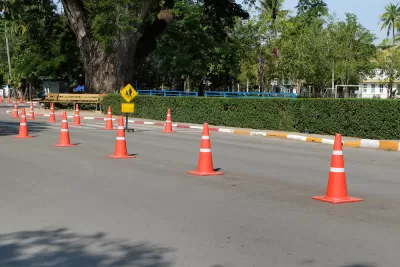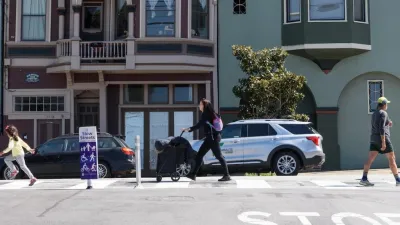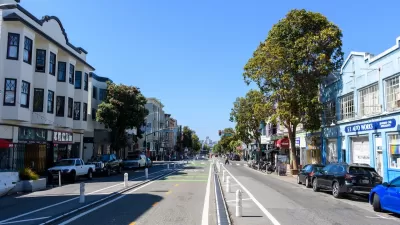The San Francisco Transformation Agency is tired of watching cyclists and pedestrians die while the city promises more Vision Zero improvements.

A group of safety activists came together to implement a DIY safety improvement project at Sixth and Mission in San Francisco "after the deaths of two bicyclists, Heather Miller and Kate Slattery, who were killed the evening of June 22 after being struck by hit-and-run motorists," according to Bryan Goebel.
The action involved placing cones along the street to create a bump-out at a notoriously busy intersection, where pedestrian infrastructure is deteriorating and often ignored by drivers.
The so-called San Francisco Transformation Agency, or SFMTrA, takes inspiration from "similar guerrilla actions in Seattle, Portland and New York," writes Goebel, in moving beyond the Vision Zero efforts of the city. "They point out that despite the city’s Vision Zero effort, which has a goal of ending all traffic deaths by 2024, 26 people have died in traffic collisions so far in 2016," adds Goebel.
In related news at the national level, Angie Schmitt reports that the National Transportation Safety Board (NTSB), usually tasked with investigating train crashes and plane crashes, has finally taken an interest in cycling fatalities. The Systematic Failure blog first noted that NTSB would investigate the fatal crash that killed five people in Kalamazoo, Michigan. Schmitt adds the extra commentary that the NTSB is still missing a larger part of the point:
Some good might come out of this investigation, but how representative is this crash of the 700+ cyclist deaths in the U.S. each year? If the NTSB wants to make a difference for bicycling safety, it should examine the systemic causes of cycling fatalities.
FULL STORY: Spurred by S.F. Cyclist Deaths, Guerrilla Safe Streets Activists Take Action

Maui's Vacation Rental Debate Turns Ugly
Verbal attacks, misinformation campaigns and fistfights plague a high-stakes debate to convert thousands of vacation rentals into long-term housing.

Planetizen Federal Action Tracker
A weekly monitor of how Trump’s orders and actions are impacting planners and planning in America.

In Urban Planning, AI Prompting Could be the New Design Thinking
Creativity has long been key to great urban design. What if we see AI as our new creative partner?

Baker Creek Pavilion: Blending Nature and Architecture in Knoxville
Knoxville’s urban wilderness planning initiative unveils the "Baker Creek Pavilion" to increase the city's access to green spaces.

Pedestrian Deaths Drop, Remain Twice as High as in 2009
Fatalities declined by 4 percent in 2024, but the U.S. is still nowhere close to ‘Vision Zero.’

King County Supportive Housing Program Offers Hope for Unhoused Residents
The county is taking a ‘Housing First’ approach that prioritizes getting people into housing, then offering wraparound supportive services.
Urban Design for Planners 1: Software Tools
This six-course series explores essential urban design concepts using open source software and equips planners with the tools they need to participate fully in the urban design process.
Planning for Universal Design
Learn the tools for implementing Universal Design in planning regulations.
planning NEXT
Appalachian Highlands Housing Partners
Mpact (founded as Rail~Volution)
City of Camden Redevelopment Agency
City of Astoria
City of Portland
City of Laramie





























